Throughout my childhood, Sundays always meant roasted meats. Every now and again, we'd have a pork loin, but usually we had either roast beef or chicken. I'm not roast beef's biggest fan -- I prefer my beef ground and grilled with a slice of cheese on top -- but until recently, I vastly preferred roast beef to roast chicken. Roast chicken was dry, tough, tasteless. The only good thing about it was gravy and the Stove Top usually paired with it. Mom would buy eight pound Purdue oven stuffer roasters and cook the hell out of them. In her defense, it's nearly impossible to properly cook a bird that big. It's the turkey paradox -- by the time the thigh is done, the white meat has the texture of saw dust.
Nowadays, though, I friggen love roasted chicken. I've discovered good quality chickens that are the perfect size for even roasting. I now exclusively buy and roast Murray's or Bell & Evans chickens, with Murray's as my bird of choice. They're a bit more money than Purdue, and for Sunday dinner, one is definitely not big enough for my family, but they are unbeatable when cooked properly. They taste like football and family and love and all that crap. Oh, and they taste like chicken!
I do most of my grocery shopping at King Kullen. They usually sell Murray's chickens for $2.59 per pound. For the three to four pound birds I love, that translates to $8-10. For two birds, the $16-20 yields more than one meal. We don't eat all the meat, and small chickens make the best stock.
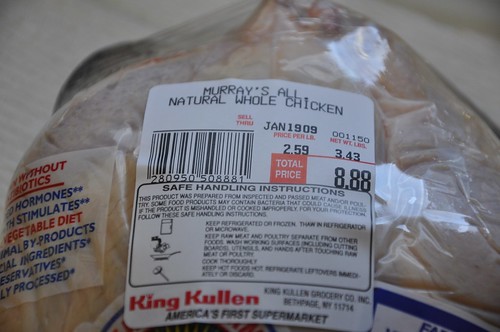
I don't exclusively buy "organic" or "natural" products. I don't trust these labels. However, I do like the idea of regional (if not local), sustainable, healthy foods that are raised, grown, or otherwise produced without manufactured products (like antibiotics, chemical fertilizers, processed feed, etc.). Murray's is doing this great thing where they label the birds with a code that allows the customer to look up the farm on which the chicken was raised. I think this is kind of cool. I like knowing where my food is coming from.

This chicken is
from Pennsylvania! It grew up on either the Brubaker Farm in Middleburg, PA or the Wertz Brothers farm in Danville, PA.
Like all Murray's chickens, this one was grown and processed without antibiotics, hormones, growth stimulants, animal by-products, artificial ingredients, or preservatives.
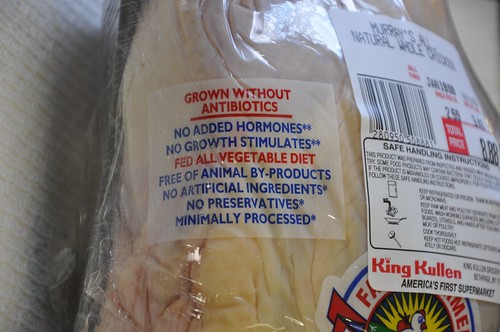
Murray's also claims that the birds are humanely raised and handled. There's a lot of information about this on the
Humane Farm Animal Care web site. Look for this label if you care about farm animal welfare.
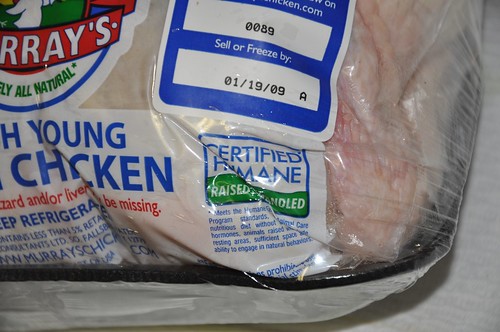
For a great Sunday dinner, it's not only important to buy the best chicken, but to cook it the best way. Start by drying it thoroughly with paper towels. Then season aggressively, especially inside the cavity. I used salt, fennel seed, celery seed, poultry seasoning, cayenne, and black pepper. (See the end of this post for amounts).
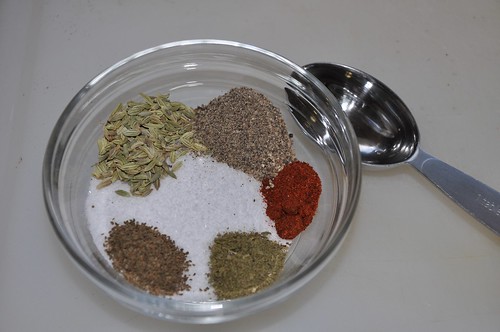
This was a more complex seasoning mix than I usually use. In general, I like salt, fennel seeds, and cayenne pepper. I tried out the celery seed here just because it sounded good, and I used a little poultry seasoning so I have less to throw away. We seem to have purchased excessive amounts of this blend during the 2008 Thanksgiving season. Really, the most important seasoning of all is the salt though. I use about a tablespoon per chicken.

I season the outside of the birds evenly and then season the cavity. I probably use two thirds of the seasoning on the inside of the chicken and the remaining third on the outside. I roasted the birds side by side in a V-rack breast side up. My technique has changed now, however. I start the birds breast side down and roast for the first half of cooking that way. If I'm just roasting one bird, I like to put cook it in my 12" cast iron skillet. It's the perfect size. If I care about presentation, I will put a small piece of parchment on the bottom of the pot so the skin does not stick and break. Usually, I don't care though.
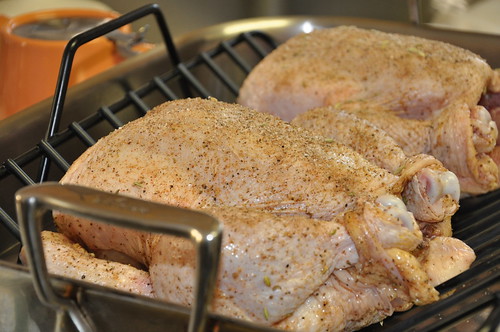
I don't truss the birds. I usually tuck the wings under and put the ends of the drum sticks in slits in the skin at the tail end. The skin shrinks as it cooks and pulls the legs in tight to the body, helping everything cook evenly. It also leaves the cavity open by pulling the skin away. This allows the heat to flow into the cavity so the bird cooks from the outside and inside. I NEVER stuff the bird. No lemon. No garlic. No onions. No herbs. Just dry seasonings.
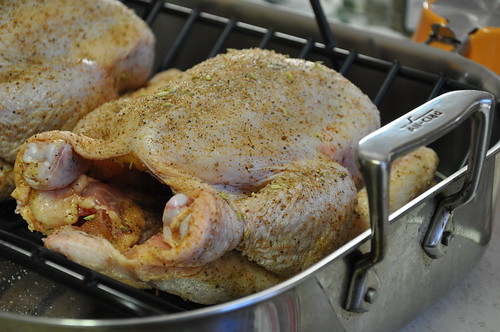
I like to roast at 400F. They take around an hour, but I always use
my thermometer to cook to 160F. I let the birds rest, but I don't cover them with foil. Then I usually just split the bird at the joints. Don't forget to eat the oysters and the Pope's nose! They are the chef's treats. On rare occasions, I will make gravy, but it usually comes out too salty. I'd rather a perfectly seasoned bird than gravy.
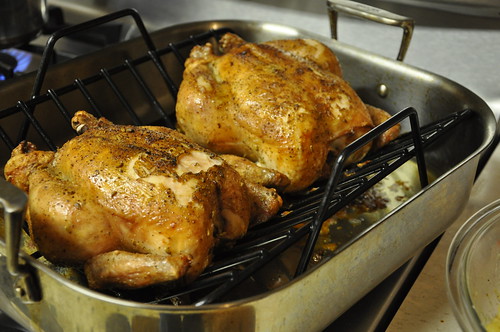
Check out that perfectly browned skin!
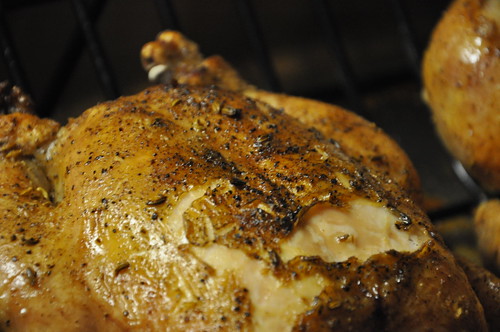
Perfect Roast Chicken RecipeAdapted from
Adam RobertsINGREDIENTS:- 2 3-4 lb chickens
- 2 tbsp salt
- 1/2 to 1 tbsp fennel seeds
- 1/4 to 1/2 tsp cayenne
METHOD:Remove chicken from refrigerator and allow to come to room temperature (1-2 hours).
Mix salt, fennel seeds, and cayenne pepper. Set aside.
Preheat oven to 400F. Line a roasting pan with parchment. Choose the smallest possible roasting pan that will accommodate both chickens.
Thoroughly dry chickens, inside and out, with paper towels. This will create a crisper skin.
Place the birds in the pan and season the cavities VERY aggressively. You should use about 2/3 of the seasoning mixture. Then, season the breast and wings of the bird, putting more seasoning on areas where the meat is thicker. Flip the birds so they are sitting breast sides down in the pan and season the backs. Focus on the legs and thighs. All your seasoning should be used up.
Roast for about 30 minutes breast side down at 400F. Flip and roast another 15 minutes. Check the temperature of the breast and thigh in EACH bird. They should be 160F. If not, cook another 10-15 minutes and check again. Repeat until the birds are done. If it takes more than 1 hr 20 mins, something is wrong. The birds were not room temperature, or your oven and/or thermometer are broken. You can cut the skin between the thigh and the body and the juices should be clear or just slightly pink. Allow to rest, uncovered, for about 10 minutes. Then carve as you like.
Serves 6-8.









